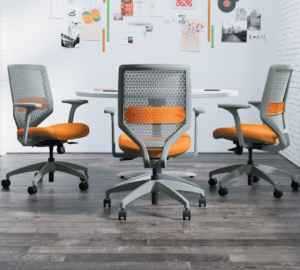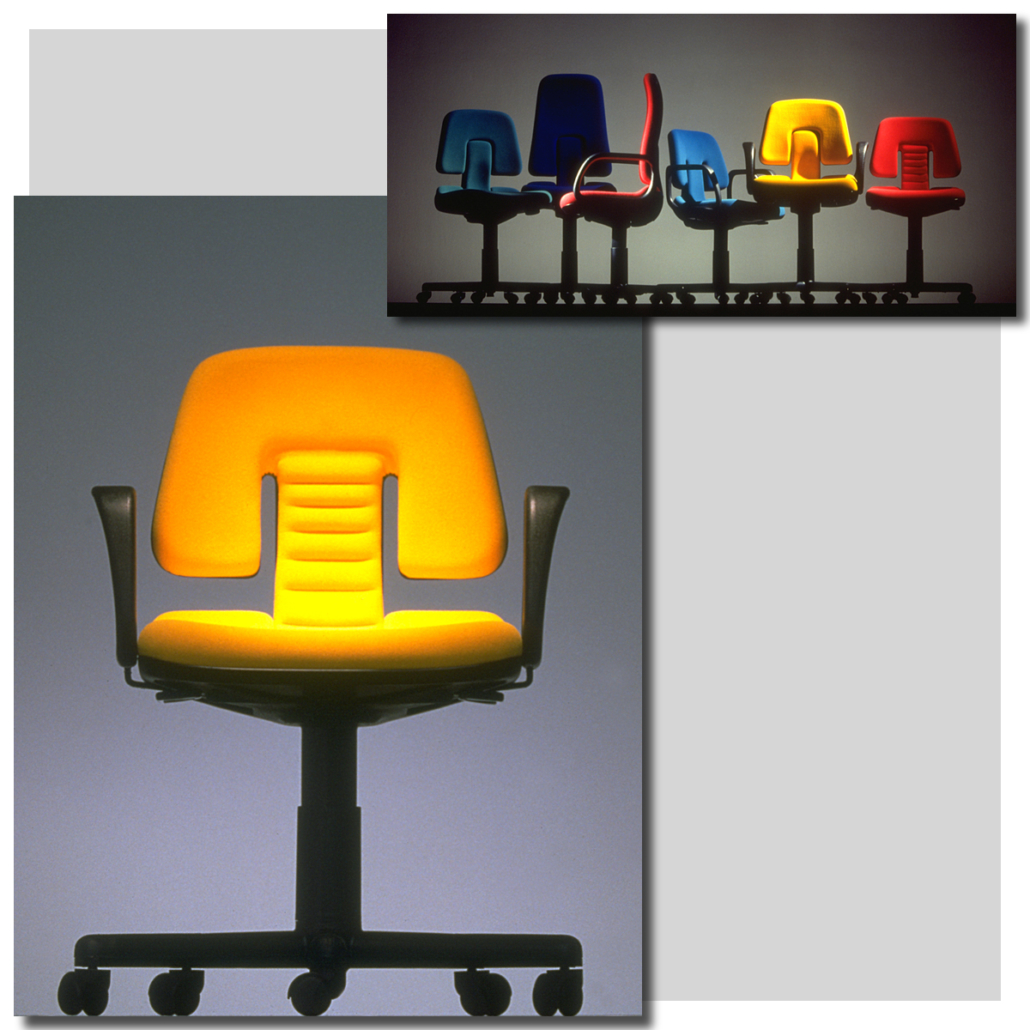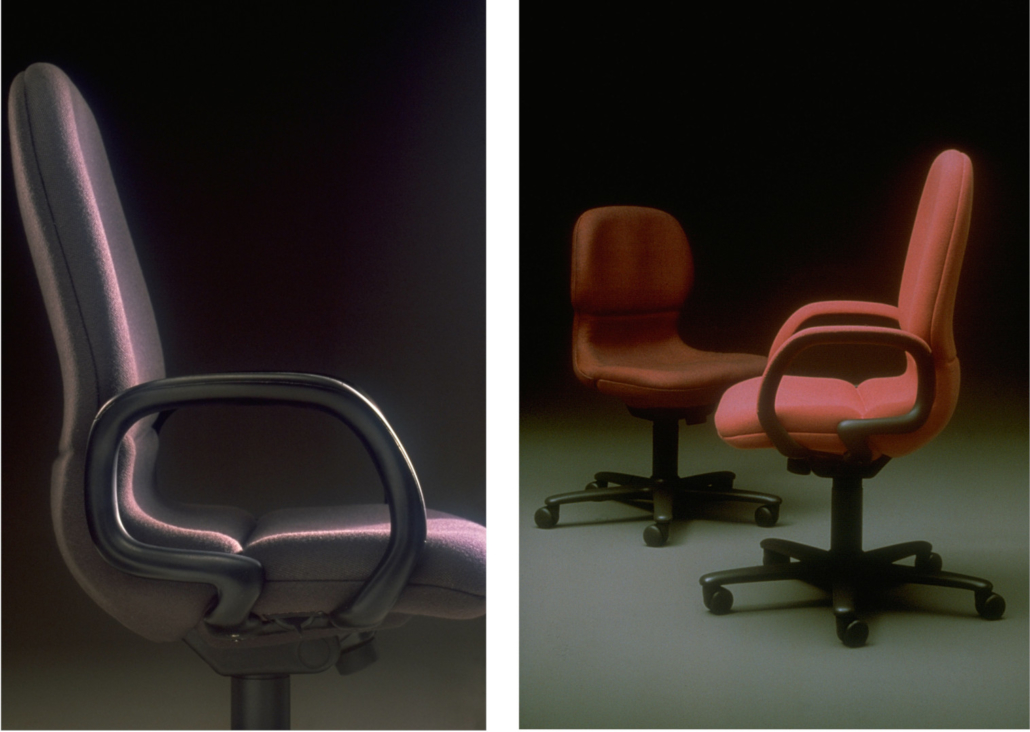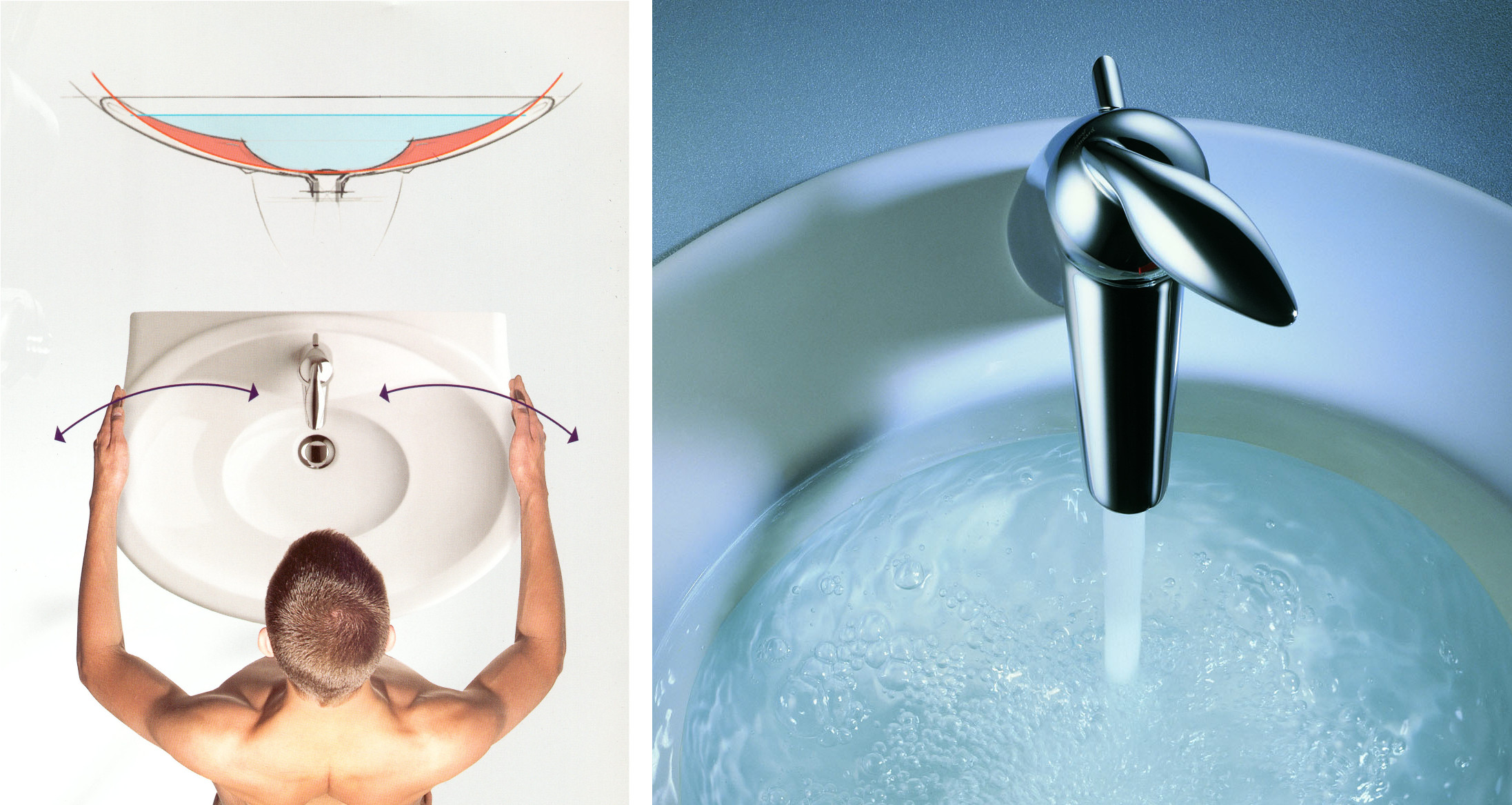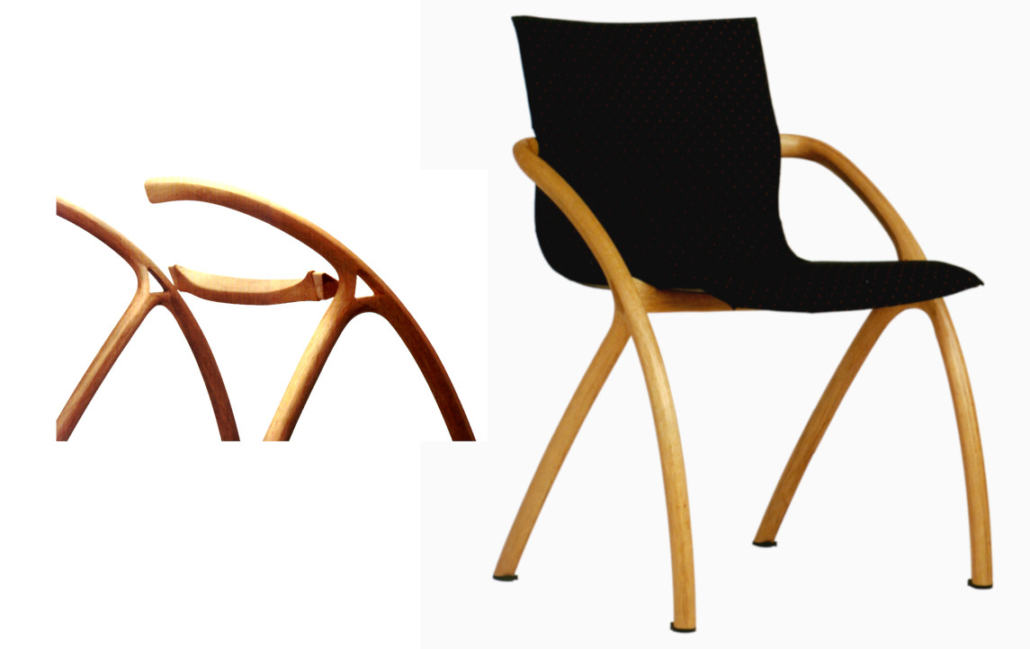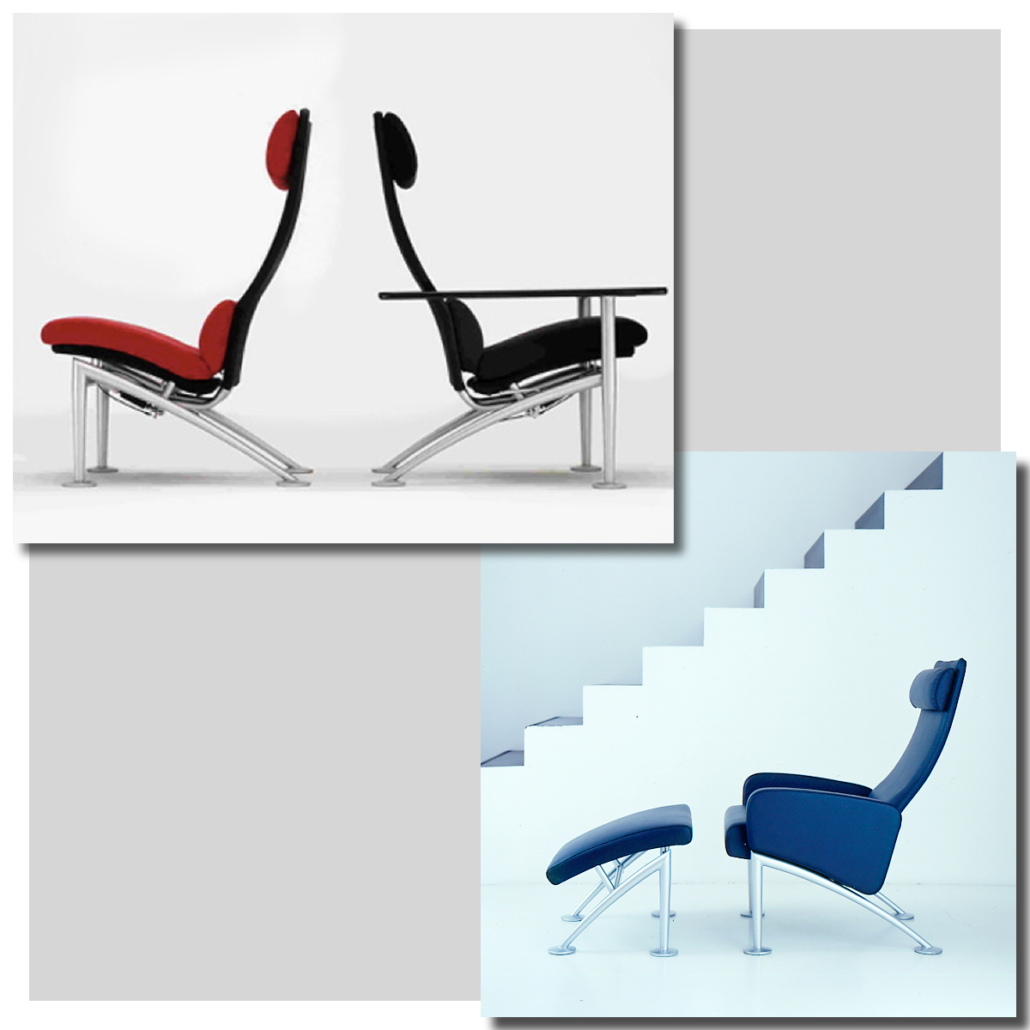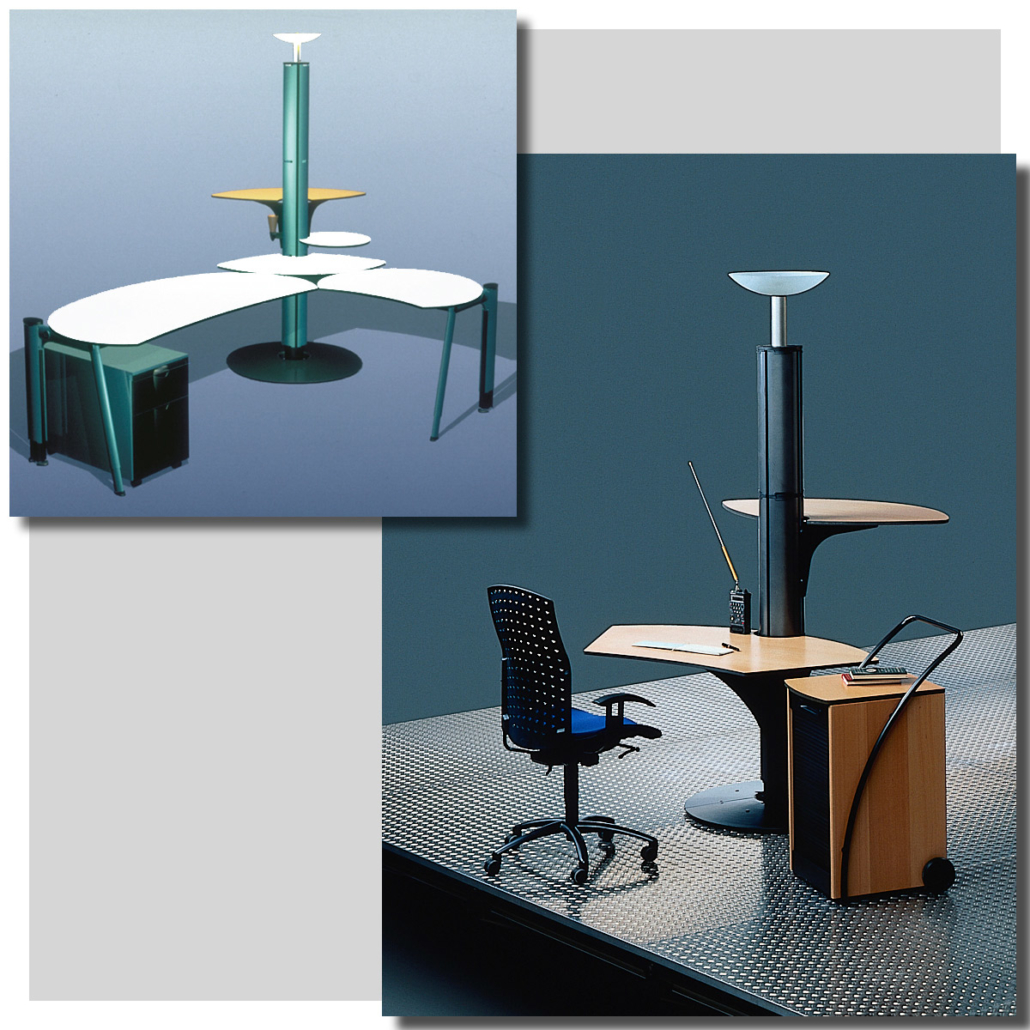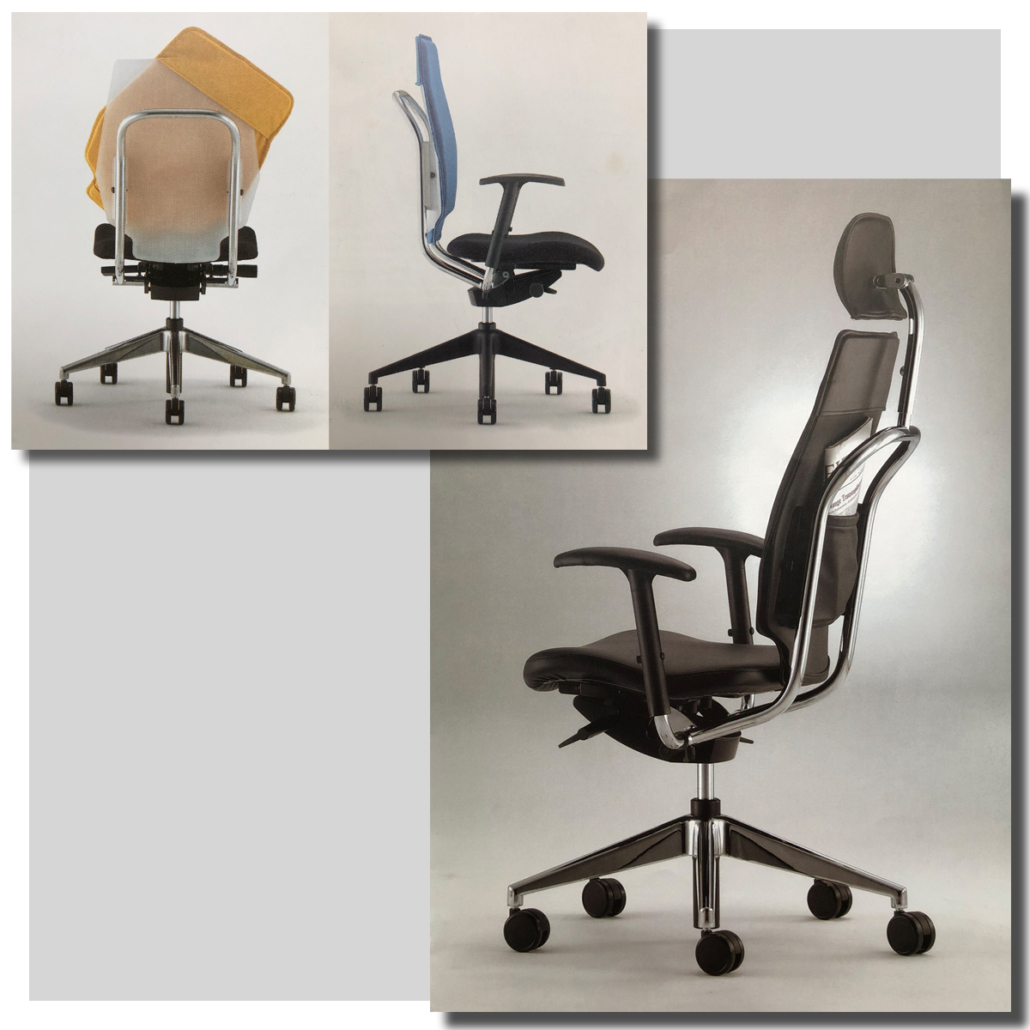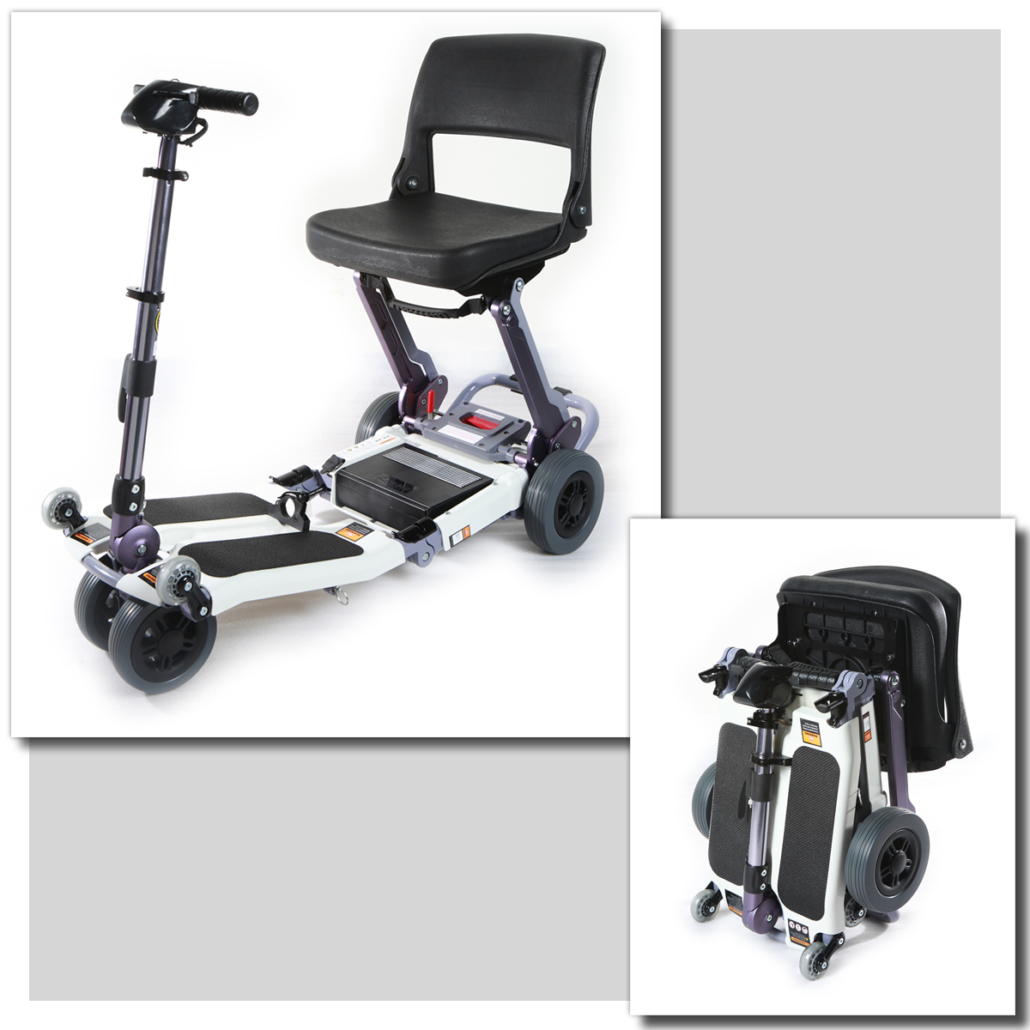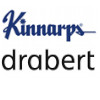V-program
Vitramat
developed from 1973-1976.
Since it’s introduction in 1976 the Vitramat has become a Classic among office chairs.
- Bundespreis für gute Form for Vitraviva, 1979
- Gute Industrieform for Vitramat, Hannover 1976/79
- Smau-Award, Italy
- Vitramat selected for Design Zentrum Stuttgart Design Zentrum NRW
Vitramat Story
Vitramat Story

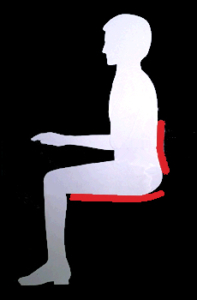
Before Vitramat, office chairs up to the 1970s resembled an upholstered board for seat and back, connected by a steel rod. The backrest could be adjusted forward and backward (upright and reclined) and up and down.
Ergonomists recommended that in the upright position the body should be supported in the lower lumbar area.
In a reclined position, the backrest should be supported in the mid to upper body area. This means that when the backrest board is adjusted from front to back, it should automatically move up und down, which it did not do.
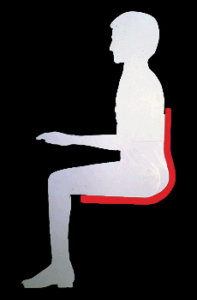
 Those chairs were only correct in one middle sitting position and not in all the others. That got us thinking about an additional lumbar pad to support the backrest in all sitting positions. The Vitramat was built up in the triad of a 3-D shaped, ergonomically designed seat, a vertical lumbar support and a separate backrest, which made adjusting the back height obsolete.
Those chairs were only correct in one middle sitting position and not in all the others. That got us thinking about an additional lumbar pad to support the backrest in all sitting positions. The Vitramat was built up in the triad of a 3-D shaped, ergonomically designed seat, a vertical lumbar support and a separate backrest, which made adjusting the back height obsolete.
What was physically correct did not comply with German DIN standard 4551, which specified a back height adjustment by law. It meant that the Vitramat concept could not be sold on the German market.
With the support of the ergonomist Prof. Peters and the vision of Vitra owner Willi Fehlbaum, changes to the standard were made, and codified in DIN 4551/52.
Changing standards is always a big deal in Germany.

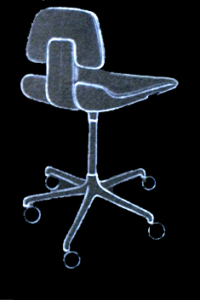
From its introduction on, the Vitramat was very successful and became the first “bread and butter” office chair development for the Vitra company.
It was in production for almost 25 years and has received several design awards. The Vitramat made Vitra famous and gave credit to Wolfgang Design as an established office chair designer

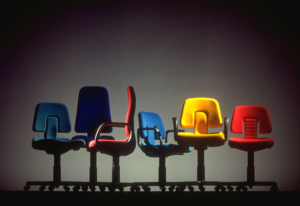
shape VIANOVA
introduced 1986
Series of porcelain and tableware.
Intensive functional and ergonomic studies have led to a new and unique design language.
VIANOVA has been published in many magazines and has been placed in special settings in famous department stores like KaDeWe, Berlin.
Vianova Story
Vianova Story
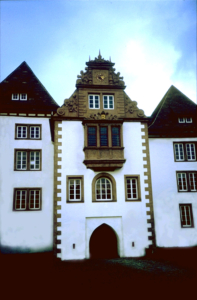
Besides technical developments with many mechanical functions, such as office chairs, pure sculptural objects made of china were challenging the designer.
After having met with the CEO of the oldest China manufacturer in the western part of Germany, Fuerstenberg, Deisig created the VIANOVA series. Traditional coffee pots feature a handle on the side, outside of the inner liquid volume, whereby the offset centre of gravity made it difficult to move the pot with hot liquid and pour the coffee out.
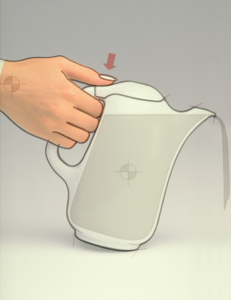
The goal was to bring the centre of gravity of the coffee pot as close as possible to the wrist joint, making it easy to handle the coffee pot and pour the coffee out. The lid was held in position by the thumb to prevent it from dropping. The VIANOVA coffee pot was one of the first ergonomically designed coffee pots and underlined the attempt to design objects for daily use as serving objects. A complete china set was designed using the same visual language.
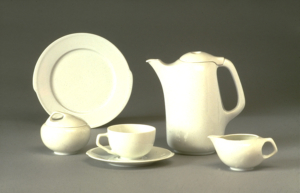
SENSOR chair
introduced 1986
Group of high-performance office-chairs for Steelcase, USA/Japan and Steelcase Strafor, Europe.
A number one selling office chair world wide.
SENSOR senses the body’s movement and responds. The shell and the synchronised tilt mechanism act as one integrated piece to react to the human body.
- IBD-Award, USA
- G-Mark Award, Japan
- Sensor has been selected for the permanent exhibition at the Cooper-Hewitt-Museum, NY
Sensor Story
Sensor Story

In the beginning of the 1980s, Steelcase/Strafor, the European subsidiary of Steelcase/USA contacted Deisig to find out if new concepts had been developed at the studio.
In the Vitramat design, single parts, such as seat, lumbar support and backrest were hinged together. The goal for SENSOR was to develop a single-piece plastic shell that flexes and moves in areas where the human body moves and supports in areas where the body needs to be supported. Polypropylene is an adequate, inexpensive plastic material, which can easily be recycled and could be ‘programmed’ to the ergonomic performance. The Steelcase engineers were very sceptical at first and pointed out that polypropylene would not have a built-in stop to prevent it from bending over and breaking.
It was very difficult to simulate the later polypropylene material with other prototyping materials in the model shop. At this time, Steelcase intoduced CATIA, an engineering and construction software.
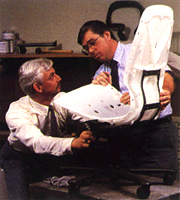
This computer software allows for an FEA, “finite element analysis” in which critical areas can be identified and calculated. After a year of prototype work and travelling back and forth over the Atlantic ocean, Deisig received the liberating call from the Steelcase engineers:
“The computer says it works!”
This was the breakthrough for the development. From now on, every single part, from the base to the mechanism and the armrests, was newly designed and developed. The entire development phase, including tooling, took almost 5 years. Sensor was introduced at the Neocon fair in Chicego in 1986 and became one of the most successful office chairs worldwide, with more than 8 million units sold.
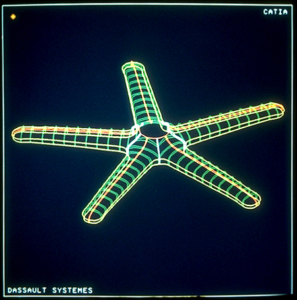

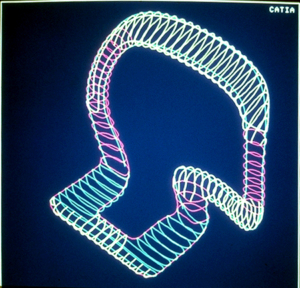
KIMERA
Cabria and Toscana in UK
Range of ceramic bathroom products introduced 1991
Intensive motion studies were done to adapt the shape and function of the bathroom ceramics to the human body. KIMERA – a bathroom line with the body in mind.
Design Innovation 1991, Design Zentrum NRW
Kimera Story
Kimera Story
After finishing the Sensor chair development, from 1987 on, Deisig decided to work on ceramic objects for the bathroom, such as lavatories, toilet and bidet bowls and accessories. Based on ergonomic studies about the human interaction with those ceramic objects, the first models were made out of styrofoam to prove these ergonomic theories. Bathroom objects need to be functional, soft in areas where the human body is in direct contact with them, easy to use and appealing to the human senses, creating a healthy bathroom spa feeling.

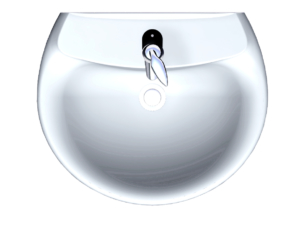
As the next step, hard shape models of the lavatories and toilet bowl were built from painted polyester. The top management of Ideal Standard Europe showed interest in the first design studies and decided to follow up on this development. Models were built using the real ceramic material.
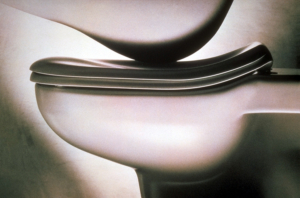
On the lavatories, the fittings are located more forward, closer to the centre of the water bowl, which is designed ‘around’ it, simulating the motion of the outflowing water. The seat area of the toilet bowl was ergonomically shaped to fit the shape of the human body and created for the first time in the history of bathroom products an innovative anthropomorphic design language.
The Kimera bathroom line was introduced in 1991 for Ideal Standard Europe, and became a best-selling product for the company that was frequently imitated by competitors. In close cooperation with Ideal Standard, Deisig developed theTENDENCE fitting line and the AVANCDE bathroom line, which were introduced in 2000.
COMPRIMO Chair
stacking chair in a new “filament wood” technique introduced 1991
The light and elegant design of the stacking COMPRIMO Chair is due to the use of an especially tough laminated filament-wood construction, which could never be manufactured by using a classical solid wood or plywood technique.
- Design Innovation 1990, Design Zentrum NRW
- shown at Technogerma, Seoul 1991
Comprimo Story
Comprimo Story

The development of the Comprimo chair is based on innovative string-wood technology, invented by the German plywood supplier Buddenberg. Layers of veneers were cut into thin Spaghetti-like strings.
A bunch of strings with added glue were compressed in a steel tool, which, for the first time, made it possible to create a frame for a wood chair in one go.
Deisig went deeper into this new wood technology and created a side frame with 3 force lines:
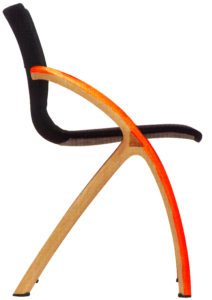
1st from the centre of the back rest over the front part of the seat to the floor ,
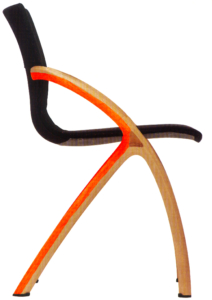
2nd from the centre of the back to the seat and to the rear on the floor,

3rd from the rear leg to the front leg
Thonet, the German manufacturer of the classical Vienna coffee-house chairs employing bentwood technology, was interested in this new string-wood chair design and brought it to the market in limited quantities.
Ultimately, this product was too expensive for mass production and was taken off the market. The essence here was to die in beauty, as is the case with some other inovative concepts. Nevertheless, the Comprimo chair won some awards and was shown at the Technogerma exhibition in Seoul/Korea as an outstanding product.
Lounge Chair UNO for Grassoler, Barcelona
Introduced 2001
Lounge Chair Seating UNO, with adjustable backrest, with and without arms.
Uno Story
Uno Story
The UNO lounge chair was designed as a working lounge with an integrated tablet for a laptop, which
allowed for the user to work in a relaxed sitting position.
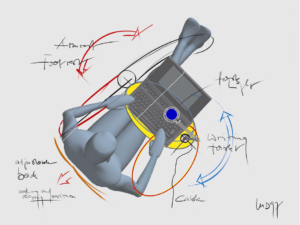
Similar to the Colonial chairs, the lower part of the armrest could be rotated to the front to support the
legs.

innovative office furniture system
for Aspa NL, Assenburg NL, Roneo F, Samas-Roneo GB, Sansen F, Schärf D
introduced at Orgatec, 1994 launched in ’95/’96
DYNAMICS acts as a bridge from the office of today to the office of tomorrow. It offers answers for the changing ways of working and shows new components, such as the free- standing column and the Kart.
- Janus de l’Industrie for Dynamics/Bureau Liberté, 1996
- ION Award, Netherlands
Dynamics Story
Dynamics Story

In the early 1990s, Samas-Groep in the Netherlands, which at the time was Europe’s largest manufacturer of office furniture, launched a design competition for the office of the future and invited fifteen leading design studios to take part. While competitions were and remain common in the world of architecture, this is not the case for design studios. The idea, however, generated considerable interest, and with the encouragement of Jan Janssen, the then-president of Samas, Deisig-Design decided to submit a proposal as a non-official competitor.
This proposal would ultimately turn out to be the winning entry.

This was a time in which the office environment was seeing fundamental changes. A fixed-line telephone and a computer linked to a single desk were becoming obsolete, and were increasingly replaced by portable equipment such as mobile phones and laptops connected to Wi-Fi that enabled work to be separated from time and space (today’s “collaborative working”).
This evolution also called for new ways of thinking about the nature of the work environment, which demanded functional solutions to meet the needs of the modern office and offer its employees a pleasant working atmosphere. Different ways of working and office layouts were analysed and complemented by innovative “free-address” workplaces for company employees who spent a good portion of their time outside their office, as is frequently the case at consulting firms, for example.
At the heart of Deisig-Design’s project debrief was a desk that could be placed within a space to meet a wide range of requirements and both combined with and connected to other items of furniture.


It gave rise to fundamentally new types of office furniture, such as a “mobile cart” and a “free-address desk tower” that, depending on usage needs, integrated adjustable work surfaces at sitting and standing height. The resulting spatial designs were a significant feature of this development.

 In 1994, after 18 months of development, the “Dynamics in Working” range was presented at the Orgatec office furniture fair in Cologne and went on to win the “Janus de l’Industrie” design award from the Institut Français du Design.
In 1994, after 18 months of development, the “Dynamics in Working” range was presented at the Orgatec office furniture fair in Cologne and went on to win the “Janus de l’Industrie” design award from the Institut Français du Design.
Samas-Groep ended production and was dissolved for economic reasons in the late 1990s. The innovative edge that this development signalled, however, was embraced by competitors and is today the standard for modern office furniture design.
Grip-Chair
introduced Oct. 2002
The Grip-Chair has been designed as a simple, light task chair, offering all important ergonomic features. A tubular steel frame carries the height adjustable backrest and ends in a grip detail, which stands for mobility. The backrest shell comes in black or translucent plastic and can be upholstered with a simple slip-over cover in fabric or leather.
Grip Story
Grip Story
The Grip chair for the German company Brune was designed as a mobile chair that could be used for several different work situations in the office, such as conference spaces, group meetings and collaborative spaces. The back upright ended in a hand grip, with which the chair could be moved throughout the office. A pocket in the back was designed to carry neccessary accessories, such as a notebook, pens, laptop and files. Instead of having several
chairs in each working situation, one chair could be used in all of them.
Grip Story
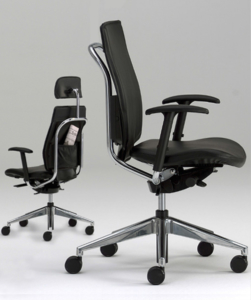
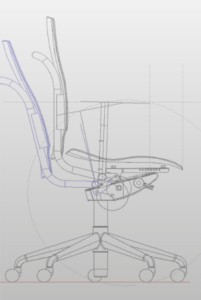
Metrix Seating
Fully featured task chair
Seat with unique ‘flex zones’ distributes the seated user’s weight evenly to relieve pressure.
Patented S-motion backrest provides proper back support from upright to reclined sitting position, keeping the eyes on the level of the computer screen.
Adjustable T-arms and unique loop arms, which can be folded to the back, when not required.
Metrix has won the 2007 GOOD DESIGN Award.
Metrix Story
Metrix Storx

Lordosis in the lumbar region creates a kyphosis in the upper back/shoulder area.
The at-rest, upright sitting position is considered to be the working position for writing
and working on the computer.
The reclined, backward sitting position is more or less a relaxed sitting position for taking
phone calls or talking to people.
When people work at a computer all day long, the reclined sitting position very often
becomes a working position.
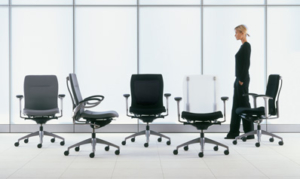

It creates enormous stress in the shoulder/neck area when trying to keep the eyes on the level of the computer screen. On the METRIX chair, the upper section moves forward automatically and supports the shoulder/neck area to relieve stress when working in a reclined sitting position.
The METRIX chair for Teknion received the 2007 GOOD DESIGN AWARD, one of the most prestigious design awards in the US.
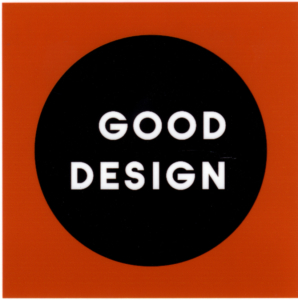
Luggie
Light pre-mobility scooter
Introduced 2009
The Luggie scooter can be folded to luggage-size for
travelling and be unfolded for driving.
Luggie Story
Luggie Story
The Taiwanese company Freerider, a manufacturer of scooters, asked DEISIG-DESIGN to develop an electric scooter with greater mobility. LUGGIE was designed as a mobility scooter that can be folded to the size of a piece of luggage and be carried in the boot of a car or taken into a train or an aeroplane.

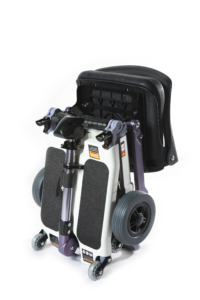
Unfolded, LUGGIE is ready to roll and with its limited dimensions can be driven indoors and outdoors. LUGGIE was the first mobility scooter on the market that could be folded to luggage size and weighed less than 25 kg. It was frequently copied by competitors. Freerider created an own brand and distribution channel for Luggie.
Further models are currently under development, chiefly under the responsibility of Nils Koehn

Developed from 2002 – 2009
Introduced June, 2010
High performance Office-Chair for Senator in the UK.
Individual adjustable panels in the lumbar and thorax area support the human body and move with it.
All technical components are concealed by an open woven fabric, which creates it’s own unique look.
The Agitus Chair comes with 3D arms, headrest and coat hanger.
Agitus Story
Agitus Story
The story of the Agitus development is that it consists of an individual lumbar and thorax pad, which can be adjusted in height and depth. It allows for individual adjustment to suit every user. Anthropometric studies show that the thorax area varies significantly more in height than the lumbar region in comparison to body height.

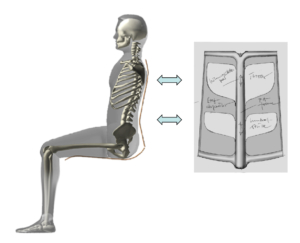
A backrest bar carries the individual pads and the backrest frame. The seat became a perforated plastic membrane for good distribution of the weight of the user. All visual components are coverted by a semi-transparent fabric sheet from the back side.

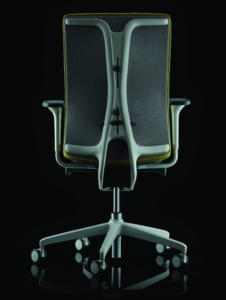
Mento Chairs
Started in 2006
Introduced March 2010
Mento is a chair line in a lower price range, which visually and functionally refers to the Drabert DNA of the Relaxoflex upper back section. The two backrest styles are height adjustable. Two visitors chairs, 4-legged and sled base complete the Mento range.
Mento Story
In 2005, the top management of Drabert, one of Germany’s longest established chair manufacturers, asked DEISIG DESIGN to develop an office chair concept for the low-end market segment that could be distributed over the internet for start-ups and smaller businesses. Each component of the chair was analysed for cost efficiency. The Mento chairs were designed with an upholstered back and a mesh back version, a simple synchro tilt mechanism and a simple back height adjustment. The Mento chairs were introduced in 2009 and are now distributed throughout Europe by the Kinnarps company in Sweden.
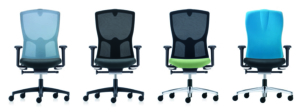

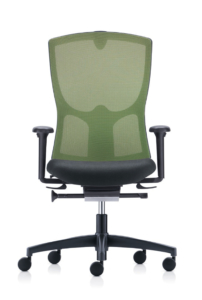
Hon / Allsteel
Cooperation since 2008
Development of office chairs, such as
Ceres, Ignition, Solve and Lyric chair lines,
Motivate multi-purpose chairs
and training tables.
Hon / Allsteel Story
Hon/Allsteel Story
In 2008, a long-lasting cooperation started with HNI/HON in the US.
For the mass market in the middle price segment, the Ignition office chair line was developed and became HON’s best selling product family.

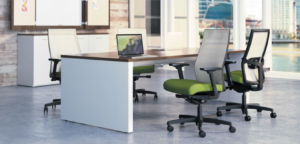
The MOTIVATE chairs, folding tables and white boards were designed for training areas and for multi-purpose use. The MOTIVATE
stacking and nesting chairs are designed with a flexing backrest for increased sitting comfort.MOTIVATE VIDEO
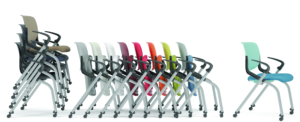


For Hon’s upper price segment, the CERES chair was developed with a permanent back support kinematic. CERES VIDEO
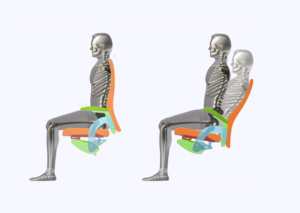
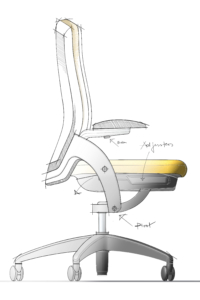

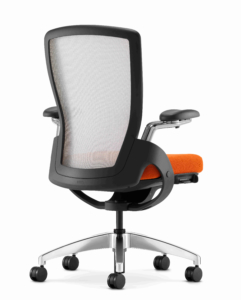
In 2014, Wolfgang Deisig and Nils Koehn designed the Lyric chair family for Allsteel, like HON an HNI subsidiary.

In the lower price segment the SOLVE chairs came to market in 2010. SOLVE is available in a mesh back version and with a perforated TPE membrane, which adapts to the body shape of the user.
